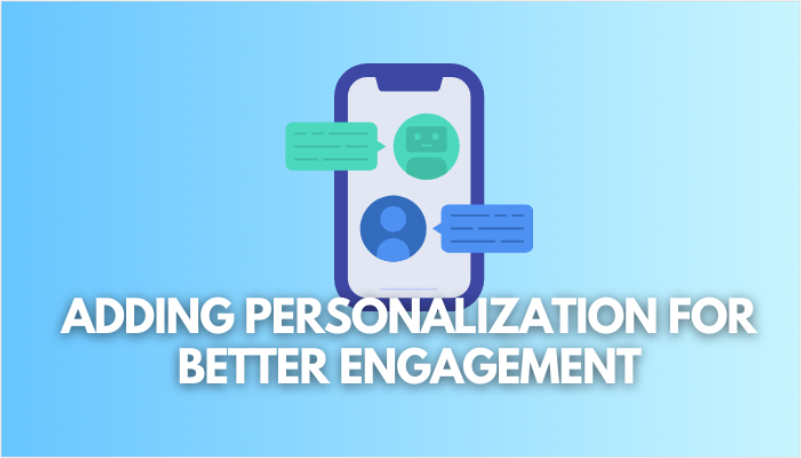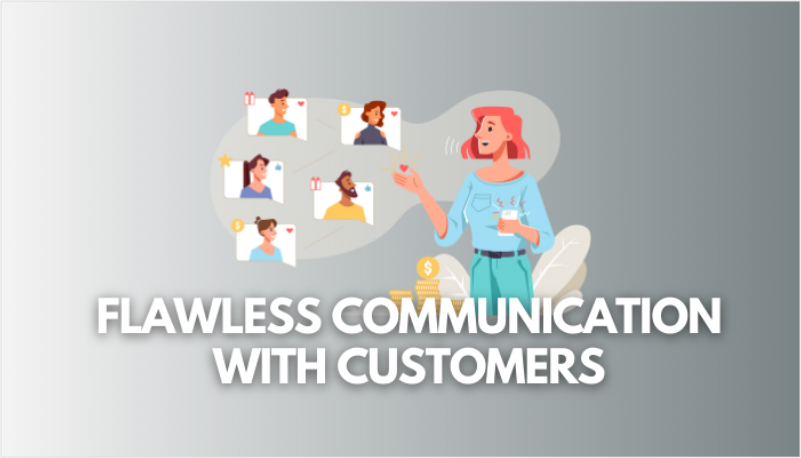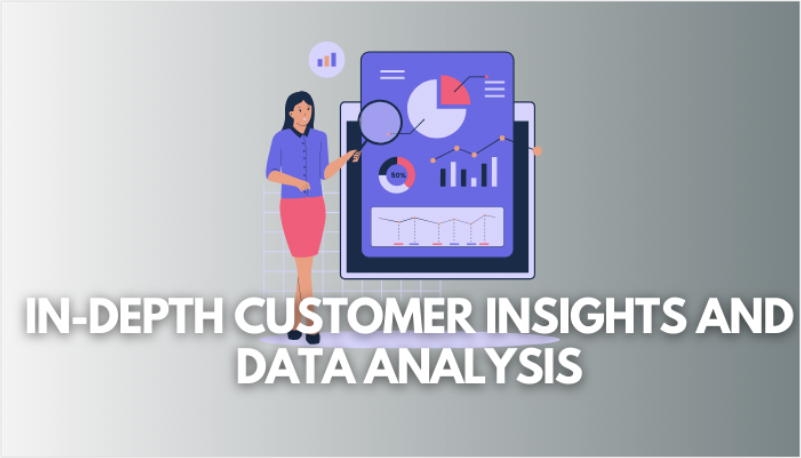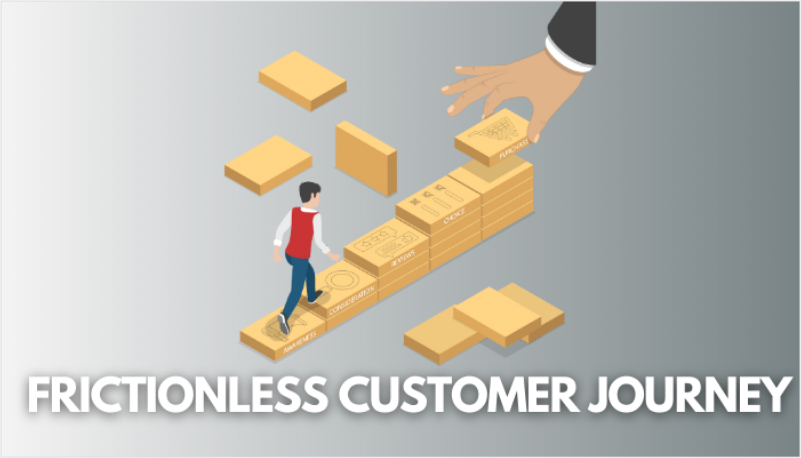The digital marketing landscape is rapidly evolving, which poses challenges to those marketers and brands who aren’t keeping up with the latest marketing trends.
The attention span of a prospect keeps on shrinking, thanks to the bombardment of content across multiple social channels.
It all leads us to understanding and implementing a powerful yet unified digital marketing strategy that works as a shield against the ever-changing social media marketing realm.
One of the modern-day marketing trends that brands are adopting is omnichannel marketing. It’s a strategy that creates coherence between different marketing and content pillars to help brands boost brand experience.
Let’s crack this open.
What is an omni-channel?
Omni-channel refers to a seamless, interactive, and useful opportunity for delivering a high-quality customer experience by channeling multiple mediums available at their disposal.
It’s the term widely used in the commerce arena where companies try to create an environment that facilitates interaction with customers through different ways, such as mobile phones, physical stores, and email.
Brands, influencers, and small businesses strive to be proactive with their engagement and communication with the users to improve customer experience and enhance brand positioning.
Therefore, a well-crafted, omni-channel marketing and engagement strategy is required to find, interact, and engage the right audience by all means necessary.
The easiest way to manage and grow your social channels.
Try ContentStudio for FREE
What is omni-channel marketing?
Omni-channel marketing is an integrated, customer-centric approach that uses all relevant channels to deliver a unified and consistent brand experience across physical stores, mobile apps, websites, and social media platforms.
The purpose of implementing an omnichannel marketing approach is to ensure that customers can seamlessly interact with the brand across different channels, enhancing their overall brand experience.
This fundamental strategy behind providing a consistent, cohesive brand experience across digital and brick-and-mortar mediums is to ensure a seamless and effective customer journey, starting from brand discovery to purchase.
Example: Standard Chartered

Standard Chartered is a British multinational banking institution operating in over 60 countries and territories worldwide.
This bank has a vibrant omnichannel marketing strategy as it capitalizes on social media, mobile apps, and live chat to engage prospects and assist customers. They can sign up for a bank account on the website and access their bank account through the mobile app.
Standard Chartered provides a seamless user experience to the account holders and truly signifies unified messaging, cohesive brand image, and consistent strategies.
Multichannel vs. omnichannel marketing
Omni-channel marketing – ensures a seamless and consistent customer journey across various marketing platforms. A well-designed omnichannel marketing strategy is distinctive and simplifies the shopping process, regardless of the marketing platform.
- Makes the shopping process easier for customers
- Emphasizes the personalized customer experience
- Delivers a unified message to the customer base
- Focuses on building a brand voice
- Creates engaging marketing campaigns based on customer interests
Example: Google Chrome

Google Chrome is a perfect example of an omnichannel marketing experience. The reason is that when a user is logged in to a Gmail account (while using the Chrome browser), the user’s data is automatically synced across all devices, such as an Android phone, laptop, smartwatch, etc.
Google intelligently uses its ecosystem of apps, web applications, and tech devices to syndicate its products and services. Therefore, it helps users boost their omni-channel marketing efforts.
Multichannel marketing – involves engaging with customers through numerous direct and indirect channels such as websites, emails, physical stores, and paid ads, aiming to connect with clients through multiple ways.
- Multichannel marketing focuses on every possible marketing channel
- This type of marketing campaign prioritizes quantity
- All customers don’t get personalized messages
- The target of such campaigns is to ensure that the messages get to the maximum number of people
Example: Subway

Subway launched a multichannel marketing campaign in the UK and Ireland in 2023. The campaign comprises both online and offline marketing channels. It was called the “Two Ways to Subway.”
This campaign used several marketing channels, including TV commercials, online paid ads, radio advertising, video on demand, outdoor advertising, social media, influencer marketing, and more. The campaign was estimated to reach 96% of 18 to 44-year-old audience through TV, VOD, and radio.
Simplified social media marketing for individuals & agencies.
Try ContentStudio for FREE
What are the significant pillars of omnichannel marketing?
To decode the concept of omni-channel marketing, it’s crucial to understand its main pillars.
i. Visibility

Visibility refers to the “clarity” and “identification” of the targeted audience you want to reach out to. Figuring out “who” you want to touch is the key to fruitful social media engagement. Brands and organizations must identify who their audience is to build a powerful marketing campaign and personalized experience for customers.
For instance, a graphics designer who specializes in logo designing should be eyeing brands with traditional and outdated logo designs and offering them new ones. This graphics designer shouldn’t be targeting newly launched companies who just got their logos designed because they won’t necessarily be interested in redesigning their logos.
So, creating a holistic view of the customer persona is one of the fundamentals of omni-channel marketing strategy.
ii. Measurement

Since omni-channel marketing uses multiple channels, even with a unified message, it’s vital to distinguish the outcome for each channel.
The key to measuring the campaign performance is to understand how each channel contributes to the campaign, whether it’s the email newsletter, social media channels, or blog posts – it’s vital to measure the performance to see what works best.
Another purpose of measuring the performance is to ensure that the campaign isn’t going off the rails. Successful brands and influencers keep track of every marketing strategy to stay well informed about their budget spending, ROI, profitability, and overall growth.
Social Media Analytics
Fine-tune your social media strategy for success with in-depth analytics and white-labeled reports.
Get Started for FREE
iii. Personalization

The attention span of social media users is at an all-time low at the moment. Brands are striving to come up with ultra-efficient marketing tactics to attract, engage, and convert the audience. No wonder one-size-fits-all marketing messages are useless – the solution to this problem is personalization.
While visibility and measurement provide significant insights into the customers’ behaviors and choices, personalization turns out to be the icing on the cake for marketing campaigns.
Once the brand has a sizeable amount of audience data to target, whether it’s the first name for email newsletters or a like-minded custom audience on Facebook, it gets easier for a brand to create a tailored-made offer that resonates with the specific audience.
iv. Optimization

Once you have built a plan, executed it well, and analyzed the results – at this stage, you know how your strategies worked out for you. However, the next up is the optimization process where you can make tweaks in your current plan to make it even better.
Whether you’re running a Facebook ad campaign or sending out email newsletters, you can always test out your strategies and tweak them over time to make your campaign optimized.
These are the four main pillars of the omni-channel marketing campaign.
Benefits of omnichannel marketing
Omnichannel marketing is all about joining forces and delivering a unified marketing message through multiple channels. It’s good to know what to expect from these efforts. Here are some of the worth-mentioning benefits of omnichannel marketing:
i. Easier customer engagement

Customer engagement is crucial to sales and marketing. Since omnichannel marketing facilitates seamless interaction with customers across various channels, it helps brands and organizations keep their prospects in the loop regardless of the platform.
Moreover, it allows businesses, influencers, and entrepreneurs to engage with customers more effectively by meeting them where they are and offering them a great experience.
Therefore, omni-channel marketing makes it easier for businesses to communicate, engage, and eventually convert the audience.
Social Customer Service
Never miss a message or comment from your social media audience. Try ContentStudio’s Inbox.
Get Started for FREE
ii. Consistent brand messaging

Brands strive to establish values, culture, and standards through their strategies and take pride when they succeed in developing a strong brand.
One of the perks of creating such an environment is that it helps those brands send out a consistent brand message.
Omni-channel marketing for brands and agencies comes in handy when their messaging remains uniform across all channels, enhancing brand recognition and trust among customers.
iii. Better customer insights

Since omnichannel marketing ensures that a unified message goes around, it assists businesses in gathering customer insights into user behavior, customer likes and dislikes, and product efficiency.
Omni-channel marketing provides businesses with a comprehensive view of customer behavior and preferences, enabling them to gain valuable insights and tailor their strategies accordingly.
iv. Higher customer retention

Customer retention is one of the secrets of long-term success that most people don’t reveal. It’s no surprise that the higher the customer retention, the higher the profitability. Positive and healthy communication with customers provides a pedestal for the growth and success of a company.
Omnichannel marketing fosters stronger relationships with customers by providing personalized experiences and consistent communication, leading to increased loyalty and higher retention rates.
v. Smooth customer journey

One of the benefits of omni-channel marketing is that it provides a seamless transition for customers, resulting in a frictionless experience throughout their journey, from discovery to purchase and beyond.
These are some of the key benefits of omni-channel marketing that everyone should keep in mind.
How to design a successful omnichannel marketing strategy
Creating a unified, effective marketing approach is easier said than done. Here are the proven steps involved in creating a powerful omnichannel marketing strategy:
i. Identify your customers’ touchpoints
The first step of designing a successful omni-channel marketing campaign is to determine the customer touchpoints. A customer touchpoint refers to the interaction of the customer with the brand, whether it’s email, mobile app, website, or online software.
It’s important to understand customer desires and preferences to build this type of marketing campaign. Conducting an audit to figure out the customer touchpoints is quite an option.
Once customer touchpoints like weekly email newsletters, mobile push notifications, or in-app banner ads are identified, it gets easier to study and enhance the customer experience.

FollowUpThen is an excellent email reminder that helps brands and individuals reach out to their prospects and convert them into paying customers. They know their customer touchpoints and simply focus on them rather than hopping on a dozen platforms.
ii. Map customer journey
After identifying the customer touchpoints, optimize the user experience by mapping out the entire customer journey. Usually, a customer’s journey begins with getting to know about the product, then the customer learns more about it, then makes a purchase, and finally becomes a loyalist.
It’s crucial to map out the customer journey which could potentially be based on multiple online and offline channels, and pinpoint pivotal touchpoints for refinement and enhancement.
Keep in mind that you’re managing multiple journeys within one campaign when implementing an omnichannel strategy. Thus, it’s essential to integrate them in real-time to prevent any inconsistencies and errors.
In simple words, mapping the customer journey means designing the whole pathway for a customer from discovery to conversion and then finally joining the advocacy club. Understanding and improvising this customer journey for a better customer experience is what mapping the customer journey is all about.

ClickMinded is an online tool that allows website owners to create customizable CTA buttons. Their team has written a complete guide on the homepage and mapped out the entire process of using this tool.
iii. Add personalization
Personalization is a game-changer strategy in the digital marketing landscape. It plays a vital role in transforming the marketing message for brands and organizations trying to reach potential buyers.
Personalization is a process of tailoring the product or service to the needs of the customer base, especially when customers are willing to share their data for advanced, efficient, and tailored outcomes. The purpose behind personalization is for businesses to grasp their pain points, challenges, needs, motivations, and priorities to cater to them well.
It’s crucial to utilize the collected data to craft a comprehensive, personalized customer journey that resonates with the brand mission. Moreover, this tactic also grants immediate access to information, enriching customer interactions.
Ultimately, omnichannel marketing does help in maximizing positivity in every interaction, resulting in discovering more ways to improve customer experience.

Pakwheels is the number one automobile classified ads website in Pakistan. They know how important adding personalization to their email newsletters is. Therefore, they use the “full name” of the user in the email newsletter to spark interest and boost engagement.
iv. Implement channels integration
An omnichannel marketing campaign requires both online and offline touchpoints to create a coherent environment for seamless communication. A successful integration of these diverse channels is essential for the core strategy to work. However, any failure in this regard could lead to significant setbacks.
A business must ensure that the user experience remains consistent whether the customer is browsing the online store, visiting the physical store, or making purchases via a mobile app. This is only possible when a channel integration strategy is in place.

ContentStudio is a powerful social media scheduling tool that allows marketers, brands, bloggers, and entrepreneurs to create, manage, and analyze social media publishing. It integrates with several mainstream social media platforms to make this SAAS tool more effective and trustworthy.
v. Measure campaign performance
Since omni-channel marketing employs multiple channels to provide an excellent user experience and deliver a consistent message throughout, there must be a mechanism to measure the performance.
Pay attention to choosing the right set of analytics tools to analyze, measure, and report the campaign performances. The omnichannel marketing strategy must be equipped to skyrocket the brand growth, improve the ROI, and put the company on an upward trajectory.

Amazon Associates provides easily digestible analytics to their affiliates who are promoting Amazon products and earning commissions on successful conversions. It helps affiliates to measure their campaigns’ performances.
These are some of the key steps in developing a successful omni-channel marketing strategy.
Top 5 tools for omnichannel marketing
1. ContentStudio

ContentStudio is an excellent social media management tool with over 120,000 satisfied users worldwide. It’s an award-winning social media dashboard that offers a wide range of tools for marketers, agencies, and influencers to manage social media.
Top features:
- Social media content scheduling
- Blog content publishing
- Social media content calendar
- Influencer discovery tool
- Team collaboration
- Workflow approval system
- AI writing assistance
- Social media analytics
ContentStudio: How it helps in omnichannel marketing
ContentStudio seamlessly connects with multiple social media and publishing platforms to streamline your content publishing at scale. It allows users to post or schedule social media content across all major social media and blogging platforms.
Since users can publish content across different social media platforms simultaneously, it assists marketers and brands in easily reaching out to prospects and customers on their preferred platforms. Therefore, it massively helps users in boosting their omni-channel marketing efforts.
2. Mailchimp

Mailchimp is a powerful email marketing software that fulfills the email marketing needs of beginner and advanced users across all industries. Plus, Mailchimp seamlessly integrates with multiple marketing and e-commerce tools to take the marketing campaign to the next level.
Top features:
- Email templates and builder
- Campaign management
- A/B testing and analysis
- Behavioral targeting
- Segmentation
- Sign-up forms
- AI-assisted marketing tools
- Reporting and analytics
Mailchimp: How it helps in omnichannel marketing
Omni-channel marketing is all about sending a unified marketing message across the board. Since one of the methods of communication with customers is email, Mailchimp can come in handy when launching an omnichannel marketing campaign.
This email marketing service offers behavior targeting, segmentation, automation, and much more that help marketers hit the bullseye. Undoubtedly, Mailchimp can be an essential tool in the omnichannel marketing arsenal.
3. Intercom

Intercom is an excellent AI-powered chatbot system that provides an opportunity for companies to set up an exceptional customer support system. It offers a fully integrated support system to brands and organizations to connect with their customers wherever they are.
Top features:
- Customizable chatbots
- Business messengers
- Live chat support
- Transactional messaging
- Mobile integrations
Intercom: How it helps in omnichannel marketing
Intercom is a pioneer in the live chat support realm. It creates opportunities for brands to communicate with customers and present them with the latest offers.
As we know omni-channel marketing is all about sending a consolidated message, and a tool like Intercom can be quite helpful in this regard. Not only does the live chat help in building a relationship with customers, but the chatbots also assist brands in engaging prospects.
So, Intercom can be useful in running an omni-channel marketing campaign.
4. Zendesk

Zendesk is a powerful customer service tool that provides a complete toolkit for launching and managing a comprehensive customer care program. It offers several customer care solutions, such as live chat, knowledge base, ticket system, and more to provide a smooth and quick response to the customers.
Top features:
- Live chat support and messaging
- AI-powered chat system
- Complete data privacy
- Effective customer support services
- Dedicated agent’s workspace
- Voice support service
Zendesk: How it helps in omnichannel marketing
Zendesk is a complete customer support toolkit that offers several communication tools for brands to attract and engage customers. Such a tool can contribute to establishing brand value by sending a unified offer through various means.
5. Shopify

Shopify stands out as an advanced e-commerce platform, simplifying the process of building online stores while offering a comprehensive solution for all e-commerce requirements. Sellers can take advantage of its all-in-one e-commerce solution that covers everything from site launching to inventory management, payment processing, sales tracking, and website analytics.
Top features:
- Drag-and-drop site builder
- Easy-to-run interface
- Diverse modules inventory
- Powerful CRM
- Effective payment processing
- Hosted platform
Shopify: How it helps in omnichannel marketing
Shopify is one of the most popular e-commerce store builders to create an online shop. In omnichannel marketing, brands use different platforms to connect with the audience, such as websites, email, mobile apps, and social media, but the campaign remains the same.
An e-commerce platform is essential to the process as it allows users to set up a website without spending hundreds of thousands of dollars on web development. Since a storefront is necessary to sell in e-commerce, Shopify lets users create easy-to-run online stores without breaking the bank.
Let’s conclude
Omni-channel marketing is an effort to improve customers’ brand experience as it capitalizes on multiple platforms to send a unified message.
The core campaign values remain the same throughout the platforms, whether it’s an email newsletter, Facebook ad, or interstitial web banner. However, the campaign design may vary from brand to brand.
The coherence among different mediums or channels reduces friction, improves conversion, and builds user trust. No wonder a lot of brands, influencers, and marketers are paying close attention to omnichannel marketing.
Experience organized workflow with a unified social media management platform for agencies.
Try ContentStudio for FREE
FAQs
What does omnichannel marketing mean?
Omni-channel marketing is a systematic approach to designing a campaign that uses all major channels to deliver a consistent brand experience across brick-and-mortar, push notifications, mobile apps, websites, and social media platforms.
What is an omnichannel strategy example?
Starbucks Reward is a great example of an omnichannel marketing strategy. It’s a powerful customer loyalty program that integrates multiple channels like app, website, and in-store to provide a comprehensive customer experience.
Is omnichannel marketing effective?
Omnichannel marketing is being adopted by brands, influencers, and small businesses across the globe. It’s quite effective when utilizing multiple channels to deliver a unified message to the audience.
